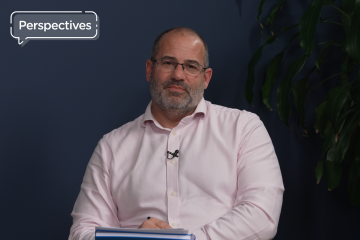

Panic attacks are sudden and unexpected episodes of severe anxiety, which may have no obvious triggers and can happen when a person least expects it. Panic attacks can be extremely frightening, and this is especially the case if the sufferer is a child.
It can be upsetting to watch your child struggle with panic attacks. You may feel helpless, and not know where to turn, or what to do for the best. However, it’s important to know you’re not alone, and there are steps you can take to help your child.
What are the symptoms of panic attacks in children?
Panic attacks can result in a range of psychological and physical symptoms which can vary from person-to-person. Your child may feel as though they’ve lost control and as though they're trapped, or are unable to free themselves from a certain situation. Panic attacks can also be accompanied by physical symptoms, which may include:
- Feeling faint, dizzy or light-headed
- Feeling nauseous
- Abdominal discomfort
- Chest pains and shortness of breath
- Heart palpitations
- Fluctuating body temperature
- Hyperventilating
In most cases, panic attacks only last for a few minutes before subsiding. However, the symptoms can sometimes make people believe they’re having a heart attack or ‘going crazy’, which can make them worry about suffering another panic attack, and ultimately lead to a ‘vicious circle.’
What causes panic attacks in children?
As is the case with most mental health conditions, research suggests there may be a number of factors that could increase the likelihood of your child experiencing panic attacks. These include:
- Hereditary/genetic factors – research shows that having a close relative (such as a parent or sibling) who suffers from panic attacks, makes it more likely that a child will also experience panic attacks
- Phobias - children may experience panic attacks as a result of being exposed to something they fear
- An existing mental health condition such as anxiety, depression, obsessive compulsive disorder (OCD) or post-traumatic stress disorder (PTSD)
- Short-term emotional triggers such as suffering a bereavement
- Low self-esteem
- Certain substances can also trigger panic attack symptoms in children, including caffeine
Navigating the young people's mental health crisis
Join our expert panel in Perspectives, where we discuss the solutions and causes of the ongoing crisis in young people's mental health. This episode features insight from clinicians and leaders in the charity sector.
Steps you can take to help your child cope with panic attacks
There are a number of things you can do as a parent, to help your child to cope with panic attacks.
Stay in control during the panic attack
If your child is having a panic attack, it’s likely they’ll feel as though they’ve lost control. This is why it’s so important for you to stay in control for the duration of the panic attack. Try to stay calm and talk to them in a gentle and soothing voice. Tell them to take deep breaths and reassure them that the panic will be over soon. Once the panic attack seems to be subsiding, give them plenty of time and space to calm down.
Breathing exercises
Explain to your child that when they’re having a panic attack, this causes their breathing to become faster, which can make them feel light-headed, dizzy and cause chest pains. Teach them to slow their breathing down; this can help to reduce the physical symptoms of a panic attack, and help it to pass more quickly. Tell your child to breathe in through their nose for 3 seconds (they should feel their chest expand when they do this), hold their breath for 2 seconds, before exhaling completely and fully. Your child can then use this breathing strategy the next time they’re having a panic attack.
Teach your child about panic attacks
Panic attacks can be frightening, and your child may be concerned about lots of things, ranging from worrying that people are laughing at them, to worrying that they’re having a heart attack or even that they’re dying. By teaching your child some of the facts about panic attacks, you can help to dispel some of these worries. Explain to your child that panic attacks are common, and they aren’t dangerous, even though they can feel scary and uncomfortable. Reassure them that panic attacks are brief, and even though they feel like they go on forever, they always end. It’s also important to let your child know that it’s likely that no-one else (other than people they’re close to), will be able to tell they’re having a panic attack, so they don’t need to worry about people laughing at them or judging them.
Encourage your child to face their fears
If your child has panic attacks in response to certain situations or objects, it’s important to encourage them to face their fears. For example, if your child gets panicky when they’re in the car, gradually expose them to this in carefully graded steps, such as sitting in a car when it’s parked, before gradually moving up to travelling in the car for very short journeys. This will help your child to realise their fears are irrational. Give your child lots of praise and encouragement throughout this process, and reassure them that they don’t have to struggle on their own.
Challenge negative thinking
The way your child thinks about things can have an impact on their levels of panic. Many of their thoughts will be out of their control and can be negative and unhelpful. Therefore, it’s important to help your child to realise that these are just thoughts as opposed to facts. Even though your child may believe a lot of their unhelpful thoughts during a panic attack, these thoughts should be challenged as they're often based on incorrect assumptions. For example, your child may think they’re having a heart attack when they're panicking, which can cause them to panic even more. Help them to challenge this thought by reminding them that when they thought they were having a heart attack previously, this wasn’t the case, and their panic attack subsided.
Help your child to shift their focus
It’s likely that your child will be having lots of negative thoughts during a panic attack. You can help to shift their focus from these thoughts by encouraging them to concentrate on something else, ideally something that soothes them or is comforting to them. This might be a favourite toy, a photograph of something enjoyable, or a pet. You could also help your child to develop a ‘happy place’ to go to inside their head. Encourage them to think of a situation or place in which they feel safe and comfortable, and tell them to focus on this whenever they feel panicky.
Reassure your child that there are always people there to help
It’s important to let your child know that they never have to suffer on their own; there will always be someone to help and listen to them. Tell your child’s teachers about their panic attacks, and ask them to step in if your child has one at school. Encourage your child to always speak to someone and be with someone if they feel a panic attack looming. Your child could also discuss their feelings with a GP, or a trained psychiatrist at a young person's assessment.
Get help
While these steps can help you to support your child, if they're experiencing persistent panic attacks, it may be that they need professional help. At Priory, our expert child and adolescent specialists can help your child to identify the causes of their panic, and support them every step of the way towards overcoming their panic attacks.
Subscribe to our newsletter
Get free monthly tips, tools and expert videos to support your mental health.
That's all in The Reset, helping you support your wellbeing - directly to your inbox each month.



